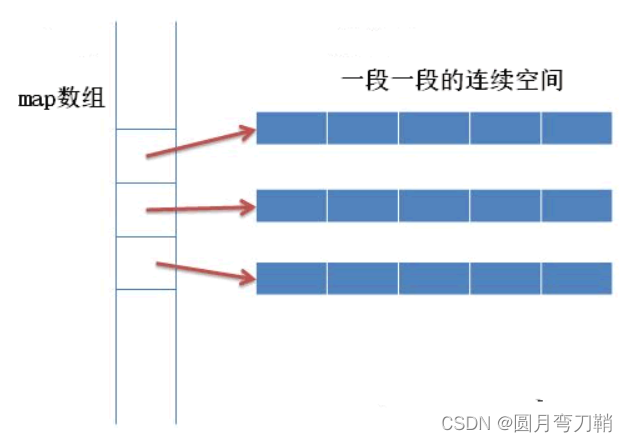文章目录
一、pair
C++中的pair是一种将两个值关联到一块儿的数据结构,使用方法如下:
#include "string"
using namespace std;
int main() {
pair<int, string> a(10, "string"); //初始化方式
a.first = 102;
a.second = "this is a demo";
cout << a.second << endl;
return 0;
}
二、vector
vector底层是一个2倍动态扩容的数组
1.vector中的迭代器
begin() – 指向第一个元素
end() – 指向最后一个元素的后面
rbegin() – 指向最后一个元素
rend() – 指向第一元素的前面
cbegin() – const迭代器,指向第一个元素,该迭代器只能读元素,不能修改元素
cend() – const迭代器,指向最后一个元素的后面,只能读取元素,不能修改元素
crbegin() – 依上类推
crend() – 依上类推
代码如下:
#include <vector>
using namespace std;
int main()
{
vector<int> g1;
for (int i = 1; i <= 5; i++)
g1.push_back(i);
cout << "Output of begin and end: ";
for (auto i = g1.begin(); i != g1.end(); ++i)
cout << *i << " ";
cout << "\nOutput of cbegin and cend: ";
for (auto i = g1.cbegin(); i != g1.cend(); ++i)
cout << *i << " ";
cout << "\nOutput of rbegin and rend: ";
for (auto ir = g1.rbegin(); ir != g1.rend(); ++ir)
cout << *ir << " ";
cout << "\nOutput of crbegin and crend : ";
for (auto ir = g1.crbegin(); ir != g1.crend(); ++ir)
cout << *ir << " ";
return 0;
}
output
Output of begin and end: 1 2 3 4 5
Output of cbegin and cend: 1 2 3 4 5
Output of rbegin and rend: 5 4 3 2 1
Output of crbegin and crend : 5 4 3 2 1
2.vector中的容量相关函数
size() – 返回容器中现有的元素的数量
max_size() – 返回容器中可以容纳的最大的元素数量
capacity() – 返回现在已经开辟的空间可以容纳元素的数量
resize(n) – 调整现有的元素数量,resize如果将原有size变小,就会删掉末尾多余的元素,如果将原有size变大,就会用默认的值对元素进行初始化
empty() – 返回容器是否为空
shrink_to_fit() – 将容器的capacity缩减到size
reserve(n) – 确保容器中至少可以容纳n个元素,如果现有的capacity小于n,容器就会扩容到n,如果现有的capacity大于n,则无事发生
代码示例如下:
#include <vector>
using namespace std;
int main()
{
vector<int> g1;
for (int i = 1; i <= 5; i++)
g1.push_back(i);
cout << "Size : " << g1.size();
cout << "\nCapacity : " << g1.capacity();
cout << "\nMax_Size : " << g1.max_size();
// resizes the vector size to 4
g1.resize(4);
// prints the vector size after resize()
cout << "\nSize : " << g1.size();
// checks if the vector is empty or not
if (g1.empty() == false)
cout << "\nVector is not empty";
else
cout << "\nVector is empty";
// Shrinks the vector
g1.shrink_to_fit();
cout << "\nVector elements are: ";
for (auto it = g1.begin(); it != g1.end(); it++)
cout << *it << " ";
return 0;
}
output
Size : 5
Capacity : 8
Max_Size : 4611686018427387903
Size : 4
Vector is not empty
Vector elements are: 1 2 3 4
3.vector中的元素操作函数
下标运算符 [g] – 返回第g个元素
at(g) – 返回第g个元素
front() – 返回第一个元素
back() – 返回最后一个元素
data() – 返回指向vector底层数组的指针
代码示例如下:
#include <vector>
using namespace std;
int main()
{
vector<int> g1;
for (int i = 1; i <= 10; i++)
g1.push_back(i * 10);
cout << "\nReference operator [g] : g1[2] = " << g1[2];
cout << "\nat : g1.at(4) = " << g1.at(4);
cout << "\nfront() : g1.front() = " << g1.front();
cout << "\nback() : g1.back() = " << g1.back();
// pointer to the first element
int* pos = g1.data();
cout << "\nThe first element is " << *pos;
return 0;
}
output
Reference operator [g] : g1[2] = 30
at : g1.at(4) = 50
front() : g1.front() = 10
back() : g1.back() = 100
The first element is 10
assign(int n, int val) – 该函数有两种用途
1.首先删除所有的元素,然后在vector中添加n次val,此法可以用于重置vector
2.假设有两个vector v1和v2,v2.assign(v1.begin(), v1.end())可用于复制v1元素到v2
push_back(int val) – 向末尾添加元素
pop_back() – 弹出末尾元素
insert(iterator) – 根据迭代器的位置插入元素
erase(iterator) – 根据迭代器的位置删除元素
swap() – 交换两个vector中的元素,即使size不同,swap做交换的原理是:
如果两个容器的空间配置器相同,就直接交换底层的成员变量,如果空间配置器不同,需要遍历容器进行交换
clear() – 清空vector
emplace_back() – C++11中新增的添加元素的方法,更高效,对应push_back()方法,当调用push或insert成员函数时,我们将元素类型的对象传递给它们,这些对象被拷贝到容器中。而当我们调用一个emplace成员函数时,则是将参数传递给元素类型的构造函数。emplace成员使用这些参数在容器管理的内存空间中直接构造元素。
代码示例如下
using namespace std;
int main()
{
vector<int> v1;
int a[] = { 1, 2, 3 };
// assign first 2 values
v1.assign(a, a + 2);
cout << "Elements of vector1 are\n";
for (int i = 0; i < v1.size(); i++)
cout << v1[i] << " ";
vector<int> v2;
// assign first 3 values
v2.assign(a, a + 3);
cout << "\nElements of vector2 are\n";
for (int i = 0; i < v2.size(); i++)
cout << v2[i] << " ";
return 0;
}
output
The vector elements are: 10 10 10 10 10
The last element is: 15
The vector elements are: 10 10 10 10 10
The first element is: 5
The first element is: 10
The first element is: 5
The last element is: 20
Vector size after erase(): 0
Vector 1: 1 2
Vector 2: 3 4
After Swap
Vector 1: 3 4
Vector 2: 1 2
三、list
list底层是带头节点的双向循环链表,头节点中存储的是当前list中的元素数量
常见操作
emplace(position, value): 同vector的emplace方法
emplace_back(value) :同vector的emplace_back方法
emplace_front(value): 同vector的emplace_front方法
list.merge(list2): 该方法用于merge list2和list1。如果两个list都是有序的,merge之后也是有序的
remove_if(condition): 删除list中符合条件的元素
unique(): 删除list中的重复元素,进行unique操作之前,list必须是有序的
list1.splice(position, list2): 将list2整个插入到list1中的某个位置之后
swap(list2): 交换两个list中的元素
示例代码如下
// C++ code to demonstrate the working of
// unique() and splice()
#include <iostream>
#include <list> // for list functions
using namespace std;
// Driver Code
int main()
{
// Initializing list1
list<int> gqlist1 = { 1, 1, 1, 2, 2, 3, 3, 4 };
// Initializing list2
list<int> gqlist2 = { 2, 4, 6 };
// Initializing list1 iterator
list<int>::iterator it = gqlist1.begin();
// using advance() to increment iterator position
advance(it, 3);
// Displaying list elements
cout << "list1 before unique operation is : ";
for (int& x : gqlist1)
cout << x << " ";
cout << endl;
// using unique() to remove repeating elements
gqlist1.unique();
// Displaying list elements
cout << "list1 after unique operation is : ";
for (int& x : gqlist1)
cout << x << " ";
cout << endl << endl;
// using splice() to splice list2 in list1 at position
// it inserts list2 after 2nd position
gqlist1.splice(it, gqlist2);
// Displaying list elements
cout << "list1 after splice operation is : ";
for (int& x : gqlist1)
cout << x << " ";
cout << endl;
return 0;
}
output
list1 before unique operation is : 1 1 1 2 2 3 3 4
list1 after unique operation is : 1 2 3 4
list1 after splice operation is : 1 2 4 6 2 3 4
四、forward_list
forward_list底层是单向循环链表,只能向前遍历,进行push和pop操作的时候只能在链表首部进行。
常见操作
assign(): 同vector
push_front()
emplace_front()
pop_front()
insert_after()
emplace_after()
erase_after()
remove(value)
remove_if(condition)
clear()
splice_after()
unique()
reverse()
五、Deque
Deque和vector的函数非常类似,逻辑上实现的是双端队列
Deque底层使用的并不是如vector一样完全连续的空间,而是如下图所示一个二维的数组

Deque的动态扩容是针对map数组以2倍方式进行的,而且扩容之后之前的内容并不是从map的开头开始存放,而是从map中间开始存放,方便进行首部和尾部的插入操作。
第二维连续空间的大小和元素类型有关,空间大小=4096/sizeof(T)






















 1963
1963











 被折叠的 条评论
为什么被折叠?
被折叠的 条评论
为什么被折叠?








